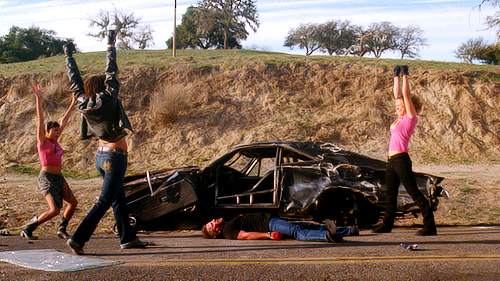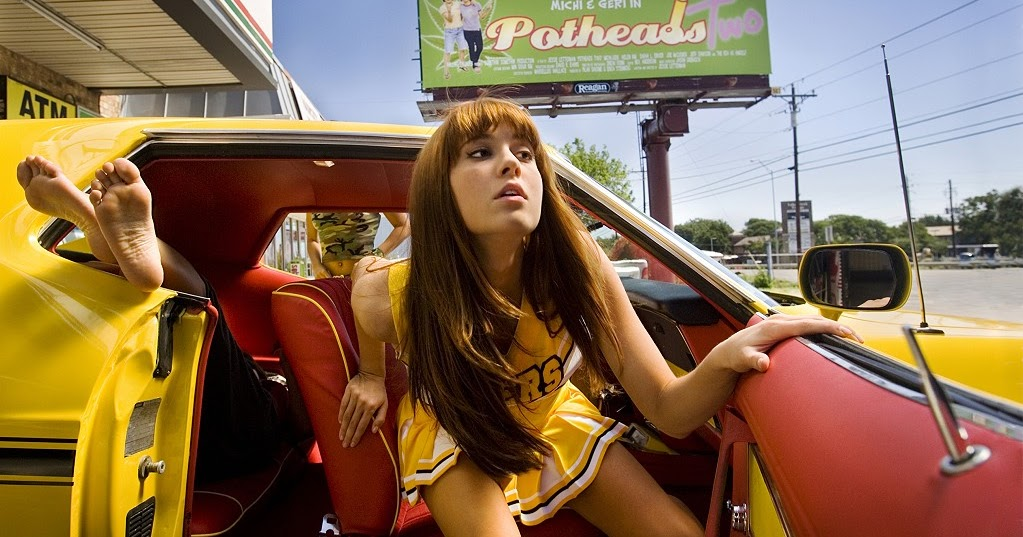Death Proof

Introduction
Death Proof (2007), written and directed by Quentin Tarantino, is a high-octane, exploitation-style action thriller that forms half of the double-feature project Grindhouse, co-directed with Robert Rodriguez. Released on April 6, 2007, by Dimension Films, the film stars Kurt Russell as Stuntman Mike, a psychopathic stunt driver who uses his “***-proof” car to stalk and eliminate young women. Featuring a stellar ensemble cast including Zoë Bell, Rosario Dawson, Vanessa Ferlito, Sydney Tamiia Poitier, Tracie Thoms, Rose McGowan, and Mary Elizabeth Winstead, Death Proof pays homage to the grindhouse films of the 1970s—low-budget, sensationalist B-movies known for their violence, ***ual content, and gritty aesthetics.
Blending visceral car chases, razor-sharp dialogue, and feminist undertones, the film stands as a unique entry in Tarantino’s filmography, channeling the raw energy of exploitation cinema with his signature storytelling.

Plot Summary
Death Proof unfolds in two distinct acts, each centered on a group of women targeted by Stuntman Mike (Kurt Russell), a charming but dangerous former stunt driver. His weapon: a heavily reinforced muscle car—a 1970 Dodge Challenger and later a 1969 Dodge Charger—designed to be “death-proof” for him alone.
In the first act, set in Austin, Texas, Mike stalks radio DJ Jungle Julia (Sydney Tamiia Poitier) and her friends Shanna (Jordan Ladd), Arlene (Vanessa Ferlito), and barfly Pam (Rose McGowan). After a night of drinks and flirtation, Mike reveals his sinister intentions. He offers Pam a ride, only to trap her in the passenger seat of his ***-proof car and crash it at high speed—emerging unharmed while the others perish in graphic slow motion.
The second act shifts to Tennessee fourteen months later. Mike’s next targets—stuntwoman Zoë (Zoë Bell), makeup artist Abernathy (Rosario Dawson), actress Lee (Mary Elizabeth Winstead), and driver Kim (Tracie Thoms)—prove to be far more resilient. While attempting a stunt involving Zoë riding on the hood of a speeding car, Mike strikes. But unlike before, these women fight back, culminating in one of the most exhilarating revenge car chases in cinema history.
The film’s dual structure—first victimization, then empowerment—mirrors the grindhouse tradition, delivering both exploitation and payback in a stylized, adrenaline-charged package.

Historical and Cinematic Context
Death Proof was conceived as part of Grindhouse, a double-feature tribute to 1970s exploitation cinema. These films—like Vanishing Point (1971), Faster, Pussycat! Kill! Kill! (1965), and Death Race 2000 (1975)—were low-budget crowd-pleasers known for outrageous action, gritty aesthetics, and ***ualized violence.
Tarantino, a passionate cinephile, infused Death Proof with deliberate visual degradation—film grain, scratches, and missing reels—recreating the look and feel of worn-out 35mm reels from old movie houses. Fake trailers directed by peers like Rob Zombie and Eli Roth added to the nostalgic vibe.
While the U.S. release of Grindhouse struggled financially, Death Proof was later released internationally as a standalone feature. The extended version added 24 minutes of character development, including a now-iconic lap dance scene.
This film sits at a crossroads of homage and reinvention—Tarantino elevating grindhouse formulas with sharp character work and a feminist twist.

Production and Direction
Tarantino took on multiple roles—writer, director, and partial cinematographer (some credited to the pseudonym “Robert Richardson”). Filming occurred in 2006 in Austin, Texas, and Santa Barbara, California. With a budget of around $30 million for the entire Grindhouse project, the production prioritized practical effects over CGI, especially in its jaw-dropping stunt sequences.
Kurt Russell, known for roles in Escape from New York and The Thing, was cast as Stuntman Mike, exuding menace with charm. Zoë Bell, a real-life stuntwoman (and Thurman’s double in Kill Bill), played herself, performing all her own dangerous sequences—especially the unforgettable scene where she clings to the hood of a car at full speed.
Supporting cast members Rosario Dawson, Tracie Thoms, and Mary Elizabeth Winstead helped ground the film with humor and charisma. The soundtrack—featuring retro tracks like “Hold Tight” by Dave Dee, Dozy, Beaky, Mick & Tich—added authenticity, while the choice to shoot real cars crashing elevated the raw, high-impact aesthetic.

Themes and Style
At its core, Death Proof is a meditation on power and vengeance. Mike represents a twisted form of predatory masculinity, hiding behind nostalgia and Hollywood stunt culture. His obsession with stalking and controlling women is eventually undone by women who are skilled, strong, and fearless—turning the tables with brutal satisfaction.
Critics often describe Death Proof as Tarantino’s most feminist work. The second act, in which the women outmaneuver and defeat their would-be predator, delivers catharsis and subverts the exploitative tone of the first half. However, the film’s explicit violence against women in the opening act remains controversial.
Thematically, it also explores obsession—Mike’s fixation with his victims echoes the voyeuristic thrill-seeking of grindhouse audiences. Tarantino’s signature style—extended dialogue, deep pop-culture references, and genre fusion—permeates the film.
Visually, the movie emulates old grindhouse films, including reels that appear damaged, shifts between black and white and color, and intentional jump cuts. While some viewers found this aesthetic immersive, others felt the pacing dragged in dialogue-heavy scenes.

Reception and Controversy
Upon its release, Death Proof received mixed reviews. The full Grindhouse feature grossed just $25.4 million domestically against a budget of $53–67 million. Critics praised the car stunts and performances—especially Russell’s—but some found the film overly indulgent.
Rotten Tomatoes gives it a 67% rating (average 6.3/10), while Metacritic lists a score of 66. Roger Ebert gave it 2.5/4 stars, highlighting Russell’s “terrific” performance but lamenting the drawn-out dialogue. Variety praised the feminist subtext and stunning car chases.
Some controversy surrounded the film’s first act, with graphic violence raising concerns over misogyny. Critics debated whether Tarantino was merely replicating exploitation tropes or critiquing them. However, many defended the film as a subversive work—one where the women ultimately take control.
Audience responses on platforms like Letterboxd and IMDb show strong cult admiration. Viewers praise the exhilarating final act and Zoë Bell’s fearless performance. The standalone extended cut, released on DVD and Blu-ray, is widely considered the definitive version.

Legacy and Availability
Death Proof holds a unique place in Tarantino’s body of work—often labeled his most underrated or experimental film. While it lacked the immediate cultural impact of Pulp Fiction or Inglourious Basterds, it has gained a devoted following over time.
It reinvigorated interest in grindhouse aesthetics and brought attention to real-life stunt performers like Zoë Bell, who went on to further acting opportunities.
The film is available to stream on platforms like Peacock, Amazon Prime Video, and Tubi, with rental or purchase options on Apple TV and other services. Physical media versions include the standalone extended cut with behind-the-scenes extras, fake trailers, and commentary.

Conclusion
Death Proof (2007) is a daring, genre-blending homage to 1970s grindhouse cinema, filtered through Quentin Tarantino’s unique vision. With Kurt Russell’s chilling portrayal of a predatory driver, Zoë Bell’s incredible stunt work, and a final act that flips the narrative, it remains a cult favorite among cinephiles. Though controversial and divisive, its commentary on gender, violence, and revenge makes it one of Tarantino’s most talked-about works—a grindhouse tribute with a feminist punch.